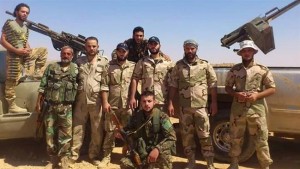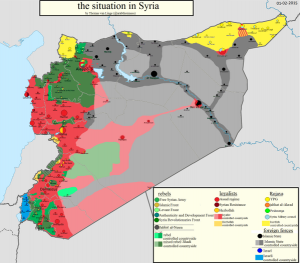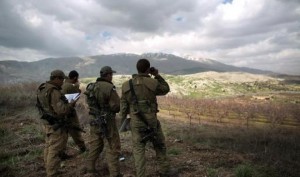The Syrian army retakes Palmyra – and looks to the east
Brian M Downing
The ceasefire in the Syrian civil war has held far better than most observers thought possible. The Syrian army has used the lull in fighting to attack Palmyra, which has been held by ISIL – a group not covered by the ceasefire. Aided by Russian airpower, the offensive has retaken a lot of territory, and is poised to retake more.
The Assad government and world opinion
The offensive is a propaganda coup for the Assad government. It is presently securing Palmyra, an historic city with Roman ruins, some of which have been destroyed by ISIL. Parts of Palmyra remain in ISIL hands, and if the protracted battle for Ramadi is any indicator, ISIL fighter will fight from pockets for weeks.
 The Syrian government is already using the partial victory as a photo op. Images of celebratory troops in remarkably tidy uniforms have been released. Spokesmen proudly assert that the world heritage site has been saved.
The Syrian government is already using the partial victory as a photo op. Images of celebratory troops in remarkably tidy uniforms have been released. Spokesmen proudly assert that the world heritage site has been saved.
A determined and successful offensive will accurately present the government, for the first time, as an effective enemy of ISIL. Heretofore, Assad has been far more concerned with fighting other rebel groups. Indeed, Assad is thought to have released ISIL prisoners so they can rejoin the war of all against all.
The same claim can be made about Russian airstrikes. Since beginning last fall, Russian planes have dropped relatively little ordnance on ISIL, concentrating instead on western- and Sunni-backed forces. Russian aircraft are now pummeling ISIL positions around Palmyra.
Syrian-Russian forces may soon move toward the ISIL capital of Raqqa, toward which Kurds and Arabs of the US-backed Syrian Democratic Forces are also moving. Proximity may cause problems.
World opinion will not suddenly favor Assad – or Putin for that matter. Assad’s forces have used chemical weapons and barrel bombs on civilians, and its militias have engaged in ethnic cleansing of Sunnis in the Mediterranean littoral where the Shia/Alawi population is concentrated, and where a rump state is forming. However, the offensive may ease world pressure for Assad to go into exile as part of negotiations.
Land grab
Syria will never be a unitary country again. It has broken apart into dozens of pieces. The ceasefire brings the opportunity of grabbing as many parts of the country as possible – to bolster negotiating positions, deprive rivals of assets, and to enhance if only superficially, national prestige.
 Taking Palmyra will open up large parts of sparsely-populated eastern Syria to reconquest. Grabbing turf there will be fairly easy. ISIL is concentrated elsewhere, preparing for the impending battles of Raqaa and Mosul. Rebel forces are unlikely to drive into eastern Syria as it would weaken their positions in more vital areas and appear to make common cause with Assad or ISIL.
Taking Palmyra will open up large parts of sparsely-populated eastern Syria to reconquest. Grabbing turf there will be fairly easy. ISIL is concentrated elsewhere, preparing for the impending battles of Raqaa and Mosul. Rebel forces are unlikely to drive into eastern Syria as it would weaken their positions in more vital areas and appear to make common cause with Assad or ISIL.
Retaking eastern Syria will also open the possibility of one day reestablishing lines of communication between Shia Syria and their fellow sectaries in Iraq and Iran. That of course would require Baghdad’s reassertion of control over the Sunni west. It would also be vigorously opposed by Saudi Arabia and Israel who have little in common except opposition to Shia power.
Israeli concerns
The Syrian-Russian campaign will of course be watched carefully in Israel. Though initially wary of the rising against Assad, who was a known foe and an intimidated one, Israel soon preferred to see Syria break apart, thereby gravely weakening the national army and Iranian-Shia power.
 It is significant that the Syrian offensive does not aim to retake the region south of Damascus, near the border with Israel. Though the Syrian army made some efforts to the east of the border, near Daraa, it has avoided going near the Golan Heights as that would lead to a vigorous and crippling Israeli response.
It is significant that the Syrian offensive does not aim to retake the region south of Damascus, near the border with Israel. Though the Syrian army made some efforts to the east of the border, near Daraa, it has avoided going near the Golan Heights as that would lead to a vigorous and crippling Israeli response.
Israel has been seeking to convince the Druze population of southern Syria to break from Damascus and become an autonomous region and informal Israeli protectorate. A Druze region would be a buffer between Israel and the Shia rump state to the north. Thus far, Israeli entreaties to the Druze have met with only limited support. Retaking the deserts of eastern Syria, away from Golan, causes concern in Israel, but not alarm.
Copyright 2016 Brian M Downing
Brian M Downing is a national security analyst who has written for outlets across the political spectrum. He studied at Georgetown University and the University of Chicago, and did post-graduate work at Harvard’s Center for International Affairs.